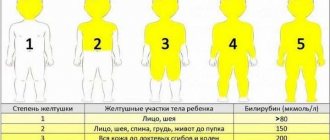Hemolytic disease of the newborn. It sounds scary, frightening - especially in combination with the touching word “newborn”. And this is a truly serious pathology that requires urgent medical intervention. According to forecasts, more than 90% of children who received timely treatment subsequently do not have neurological disorders. Therefore, you cannot hesitate; you need to diagnose it in time and take action.
Since, as a rule, TTH manifests itself in the first days of a child’s life, treatment is prescribed immediately, please trust and do not interfere with the actions of doctors!
So, what kind of disease is TTH? This is the destruction of the red blood cells of a newborn baby by the antibodies of his mother. And the reason for it is the incompatibility of maternal and child blood in terms of red blood cell (erythrocyte) antigens, usually the Rh factor and the blood group system, and, sometimes, other blood factors.
What is the reason?
If the mother has Rh negative blood and the child has Rh positive blood, then Rh incompatibility occurs. Because of this, the mother’s immune system can identify the fetus’s red blood cells as potentially dangerous, foreign, and begin to produce antibodies against the Rh factor located on them. Having attached to the child’s red blood cells, antibodies destroy them. Moreover, this process begins during the period of intrauterine development of the fetus and continues after the birth of the child. If the fetus has Rh-negative blood, and the mother has Rh-positive blood, then this situation does not arise.
Prevention of tension-type headache
Hemolytic disease of the newborn (HDN) is a pathological condition of the newborn, accompanied by massive breakdown of red blood cells, and is one of the main causes of the development of jaundice in newborns. Hemolytic disease of newborns (morbus haemoliticus neonatorum) is hemolytic anemia of newborns, caused by incompatibility of the blood of mother and fetus according to the Rh factor, blood group and other blood factors. The disease is observed in children from the moment of birth or is detected in the first hours and days of life.
Hemolytic disease of newborns, or fetal erythroblastosis, is one of the serious diseases of children in the newborn period. Occurring during the antenatal period, this disease can be one of the causes of spontaneous abortions and stillbirths. According to WHO (1970), hemolytic disease of the newborn is diagnosed in 0.5% of newborns, the mortality rate from it is 0.3 per 1000 children born alive.
Clinical symptoms depend on the form of the disease.
The edematous form (or hydrops fetalis) is rare. It is considered the most severe form among others. As a rule, it begins to develop in utero. Miscarriages often occur in early pregnancy. The skin of such a newborn is pale, waxy in color. The face is round in shape. Muscle tone is sharply reduced, reflexes are suppressed. The liver and spleen are significantly enlarged (hepatosplenomegaly). The belly is large and barrel-shaped.
The anemic form is the most favorable form according to the course. Clinical symptoms appear in the first days of a child’s life. Anemia, pallor of the skin and mucous membranes, and an increase in the size of the liver and spleen gradually progress. The general condition suffers slightly.
The icteric form is the most common form. Its main symptoms are:
- jaundice (yellow coloration of body tissues due to excessive accumulation of bilirubin (bile pigment) and its metabolic products in the blood);
- anemia (decrease in hemoglobin (the coloring substance in the blood that carries oxygen) and red blood cells per unit volume of blood);
- hepatosplenomegaly (enlargement of the liver and spleen in size).
Forms.
Depending on the type of immunological conflict, the following forms are distinguished:
- hemolytic disease of newborns (HDN) due to a conflict on the Rh factor;
- hemolytic disease of newborns (HDN) due to blood group conflict (ABO incompatibility);
- rare factors (conflict with other antigenic systems).
Clinical forms:
- edematous;
- icteric;
- anemic.
The following forms of the disease are distinguished according to severity.
- Mild form: diagnosed in the presence of moderate clinical and laboratory data or only laboratory data.
- Moderate form: there is an increase in the level of bilirubin in the blood, but there are no bilirubin intoxication or complications yet. This form of the disease is characterized by jaundice that appears in the first 5-11 hours of the child’s life (depending on the Rh-conflict or ABO-conflict), the hemoglobin level in the first hour of life is less than 140 g/l, the level of bilirubin in the blood from the umbilical cord is more than 60 µmol /l, increased size of the liver and spleen.
- Severe form: this includes an edematous form of the disease, the presence of symptoms of damage to the nuclei of the brain by bilirubin, respiratory disorders and cardiac function.
Prevention of hemolytic disease in newborns.
The basic principles of prevention of hemolytic disease of newborns are as follows.
Firstly, given the great importance of previous sensitization in the pathogenesis of hemolytic disease of the newborn, each girl should be treated as a future mother, and therefore girls should undergo blood transfusions only for health reasons.
Secondly, an important place in the prevention of hemolytic disease of newborns is given to working to explain to women the harm of abortion. To prevent the birth of a child with hemolytic disease of the newborn, all women with Rh-negative blood factor are recommended to administer anti-O-globulin in an amount of 250-300 mcg on the first day after an abortion (or after childbirth), which promotes the rapid elimination of the child’s red blood cells from the blood mother, preventing the synthesis of Rh antibodies by the mother.
Thirdly, pregnant women with a high titer of anti-Rhesus antibodies are hospitalized for 12-14 days in antenatal departments at 8, 16, 24, 32 weeks, where they are given nonspecific treatment: intravenous infusions of glucose with ascorbic acid, cocarboxylase, prescribed rutin, vitamin E, calcium gluconate, oxygen therapy; if a threat of miscarriage develops, progesterone and endonasal electrophoresis of vitamins B1 and C are prescribed. 7-10 days before birth, phenobarbital 100 mg three times a day is indicated.
Fourthly, when a pregnant woman’s anti-Rhesus antibody titres increase, delivery is carried out ahead of schedule at 37-39 weeks by cesarean section.
How not to miss the symptoms of hemolytic disease
While the mother is pregnant, signs of blood incompatibility do not manifest themselves in any way in either the mother or the fetus. And after birth, HDN clinically manifests itself in different ways, depending on what form it takes: anemic, icteric and edematous. There are also cases of a combination of these forms. Let's look at them separately.
1. Anemic form. It is considered the easiest. Its manifestations are pallor of the skin, neurological disorders, for example, too much sleep, lethargy, apathy, poor appetite, and a sluggish sucking reflex. In addition, there are signs of enlargement of the spleen and liver, observed over time.
2. Jaundice form. The most common form. It is diagnosed in almost 90% of cases. With this form, jaundice is the most important symptom. Literally in the first hours of life, the skin and mucous membranes acquire a yellow tint, and enlargement of the liver and spleen is possible. The severity of the jaundice form is determined by the distribution throughout the body and the intensity of jaundice. This is determined visually using the Cramer scale. There are five degrees in total, with the first affecting the face and neck, and with the fifth the whole body. The intensity of jaundice depends on the level of bilirubin, which gives the skin its yellow color. A critical level of this enzyme can affect the neurons of the brain, its structures, and cause a serious and dangerous complication, bilirubin encephalopathy.
3. Edema form (“hydrops fetalis”). This is the most severe form, most often diagnosed in utero. The icteric coloration of the membranes, amniotic fluid, and umbilical cord did not go unnoticed by doctors. From the moment of birth, the child has swelling throughout the body - subcutaneous, abdominal, chest. The condition of the newborn is serious. Children diagnosed with this particular form of the disease require intensive treatment, including blood transfusions.
Immediately after birth, it is important for children, especially those at risk, to determine their blood type . Children who do not have the same blood type or Rh group as their mother should be examined by a doctor several times during the first day of life.
Mom herself may notice jaundice, as well as excessive pallor of the mucous membranes and skin. In this case, you must immediately inform your doctor.
HDN should not be confused with other diseases of newborns:
- hereditary hemolytic or posthemorrhagic anemia;
- non-immune hydrops fetalis;
- various infections, etc.
Only a doctor can make an accurate diagnosis; do not try to make a diagnosis yourself or downplay its importance.
Hemolytic disease (HDN) - symptoms and treatment
The development of hemolytic disease is possible only through contact between the blood of the mother and the fetus. During pregnancy, thanks to the placenta, fetal red blood cells enter the mother's body in small quantities, insufficient for the production of antibodies. At the time of delivery, due to abortion, miscarriage or complicated pregnancies, red blood cells enter the mother's bloodstream in large quantities, which causes the production of class M antibodies (IgM). These antibodies are formed almost immediately after contact with Rh-positive fetal blood. They provide temporary immunity from any foreign substances, but IgM are not able to penetrate the placenta to the baby.
Antibodies of class M are then transformed into antibodies of class G (IgG). They are produced 3 months after contact with Rh-positive red blood cells, provide long-term immunity for several years and are able to pass through the placenta into the fetal blood. This explains the fact that during the first pregnancy, these immune particles are not dangerous for the fetus, because during a normal pregnancy, the child’s blood mixes with the mother’s blood only in the last months of pregnancy or after childbirth, when IgG has not yet been developed.
During the first pregnancy, only recognition of the fetal red blood cells occurs, i.e., a primary immune response, which is also called “irritation” of the mother’s immune system. The term “sensitization” is also used for this process, and when applied to Rh conflict - “Rh sensitization”. The primary immune response is not dangerous to the fetus.
As a rule, a conflict regarding the Rh factor develops during a second pregnancy. This is due to the fact that by the time of the next conception, class G antibodies are already present in the mother’s body, so they begin to attack the red blood cells of the fetus already in the early stages. In this regard, the likelihood of developing this disease, as well as its severity, increases with each subsequent pregnancy. The disease occurs in 63% of children from women with sensitization.
It is important to understand that in the case of an abortion during the first pregnancy, regardless of the method used, the likelihood of sensitization (antibody production) in women with a negative Rh factor increases significantly. At the same time, the risk of infertility increases.
Maternal antibodies destroy fetal red blood cells in the liver and spleen, which disrupts the functioning of these organs. With a large amount of antibodies, damage to red blood cells occurs inside the vessels. In response to the death of red blood cells, the liver, spleen and bone marrow begin to produce reticulocytes (red blood cell precursor cells), which leads to their increase. This explains the development of symptoms of anemia and hepatosplenomegaly (enlarged liver and spleen) [7].
The breakdown product of red blood cells is indirect bilirubin, a bile pigment. Bilirubin is a toxic enzyme that damages the tissues of the brain, liver, lungs, kidneys, etc. A critical increase in the level of indirect bilirubin leads to irreversible damage to brain structures - bilirubin encephalopathy (kernicterus).
Factors in the development of kernicterus are prematurity, infections, hypoxia (lack of oxygen in the fetus), metabolic disorders (low or increased blood glucose levels), hemorrhages, taking certain medications (sulfonamides, salicylates, furosemide, diazepam, etc.) and alcohol consumption [2].







